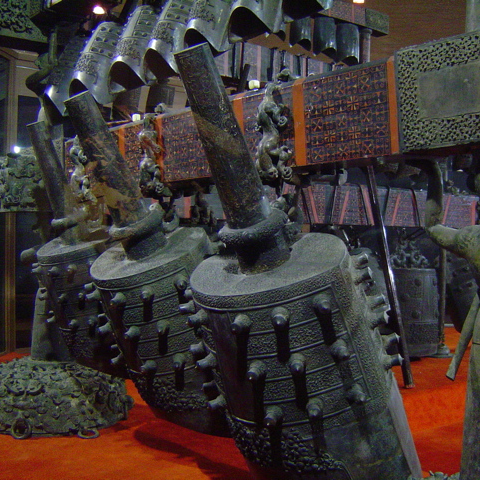zhong overview
 The chime (pinyin: Zhōng) is a traditional Chinese percussion instrument that began in the Bronze Age. The bells are cast in bronze, and different bells are arranged according to size and hang on a huge bell stand. Chimes are often used in combination with chimes; the "gold" in "Sound of Gold and Stone" refers to chimes, and "stone" refers to chimes.
The chime (pinyin: Zhōng) is a traditional Chinese percussion instrument that began in the Bronze Age. The bells are cast in bronze, and different bells are arranged according to size and hang on a huge bell stand. Chimes are often used in combination with chimes; the "gold" in "Sound of Gold and Stone" refers to chimes, and "stone" refers to chimes.A bell with a handle at the top is called a Yong bell, and a bell with a button on the top is a button bell. "Zhou Li·Kaogong Ji" records that "The mallard is the bell, and the two luans are called milling. The milling is called Yu, the drum is called the drum, the drum is called the drum, and the drum is called the dance. The dance is called Yong. The Yongshang is called the balance, the Zhongxian is called the spin, the spinach is called the stem, the bell belt is called the seal, the seal is called the piece, the piece is called the scene, and the grip on the top is called the tunnel.” That is, one of them is flat. The flat top of the barrel is called "dance", the straight and wide strips in the middle and upper part of the front and back of the flat barrel are called "zheng", and the protruding breast nails (long bags) on both sides are called "mei" or stalactites. Part of it is called "seal". The lower part is called "drum", the concave lower part is called "yu", and the sharp sides are called "milling".
The handle of the bell is called "Yong" or "Button" respectively by pressing the Yongzhong or the button clock. The top of the "Yong" is called "Heng", the protruding part in the middle of the "Yong" is called "Xuan", and the hole on the "Xuan" used to hang the bell hook is called "Dan". The hanging method of the Yong bell is inclined, and the button bell is hung straight. It is generally believed that the straight-hanging button bell is later than the obliquely-hanging Yong bell.
The bell hangs on the rack and plays. The bell frame was called "sun ju" (Sǔn, jù) in ancient times, and the beam was "sun", which was also used as bamboo shoots and cobalt; There is a "tarsal seat" under the column for stability. Due to the different number of hanging bells in each group (set), there are many kinds of frame systems. Such as one beam and two columns (the bells of the Chu tomb in Xinyang, Henan, 13 pieces); two beams and five columns (the bells of the Tomb No. 1 Tianxingguan in Jiangling, Hubei, 22 pieces); pieces); seven beams and fourteen columns in the shape of a curved ruler (the bell from the tomb of Zenghou Yi, sixty-four pieces), etc. Some bells were unearthed with hooks, piercing nails and bells and sticks that struck the bell body. Yong bells are hung with bell hooks or ropes, and button bells are hung with nails. To play small and medium chimes, use T-shaped wooden chimes; to play large bells, use long round wooden sticks. Take the tomb of Marquis Yi of Zeng as an example. Its T-shaped bell is 62 cm long and the wooden stick is 215 cm long.
So far, the number of chimes found in the pre-Qin period has been considerable. According to incomplete statistics in 1988, there are 116 batches, 174 groups, and 903 pieces (the type, group, and pieces are not counted) inside). Among them, there are about 400 inscriptions.
- Pinyin:Zhōng
- type:percussion
- alias:chimes
overview of other similar instruments
- sanyanxiao overview
- Daguangxian overview
- Leiqin overview
- hahao overview
- yandundagu overview
- Han Xiaozheng overview
- Fang Xiang overview
- guanzi overview
- zhuqin (Dao Qin) overview
- zhuiqin overview
- bangzi overview
- three-stringed piano overview
- Gehu overview
- xiao overview
- xiaokonghou overview
- Konghou overview
- Sheng overview
- suona overview
- hulusi overview
- gushao overview
 渝公网安备 50010702504639号
渝公网安备 50010702504639号